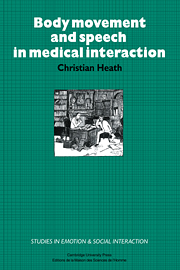Book contents
- Frontmatter
- Contents
- Preface
- The transcription system
- 1 Video analysis: interactional coordination in movement and speech
- 2 The display of recipiency and the beginning of the consultation
- 3 Maintaining involvement in the consultation
- 4 Forms of participation
- 5 The physical examination
- 6 Taking leave of the doctor
- 7 Postscript: the use of medical records and computers during the consultation
- Notes
- References
- Index
7 - Postscript: the use of medical records and computers during the consultation
Published online by Cambridge University Press: 19 January 2010
- Frontmatter
- Contents
- Preface
- The transcription system
- 1 Video analysis: interactional coordination in movement and speech
- 2 The display of recipiency and the beginning of the consultation
- 3 Maintaining involvement in the consultation
- 4 Forms of participation
- 5 The physical examination
- 6 Taking leave of the doctor
- 7 Postscript: the use of medical records and computers during the consultation
- Notes
- References
- Index
Summary
One has reached the conclusion that the key to good general practice is the keeping of good clinical records. Time and again one has seen a quick glance through a well-kept record card provide either the diagnosis or an essential point in treatment.
Taylor 1954, p. 35We believe that a compatible computer system could (and should) be in widespread use in general practice in five years, and adopted by virtually all practices in ten years.
Royal College of General Practitioners 1980, p. 42As Weber pointed out in his classic theory of bureaucracy, files and documents are an essential feature of the modern organization, both in the public sector and the advanced institutions of capitalism. The modern medical organization is no exception. Both time and money are devoted to documenting information concerning the transactions between personnel and their clients. An example of such documents is the medical record card. As even the most cursory visit to a medical organization reveals, a great deal of energy is directed to recording and retrieving from documents the medical biography of patients. Taylor's remarks quoted at the beginning of this chapter reflect a widespread concern in primary care with the importance of medical record cards to good clinical practice.
Medical record cards in general practice consist in large part of brief descriptions of consultations, each consultation warranting a description, a single entry in the records. Though brief, the descriptions typically contain details concerning the assessment and management of a case and whether any referrals, sick notes, and prescriptions were given to the patient.
- Type
- Chapter
- Information
- Body Movement and Speech in Medical Interaction , pp. 153 - 173Publisher: Cambridge University PressPrint publication year: 1986



